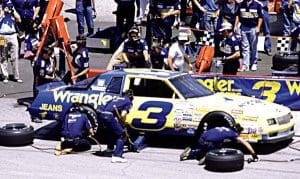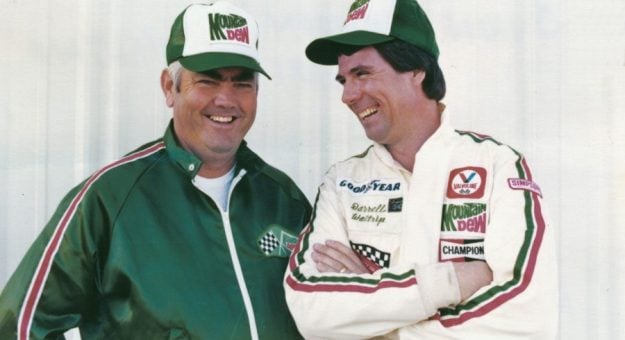One year after earning rookie-of-the-year honors in the NASCAR Cup Series, Dale Earnhardt drove California businessman Rod Osterlund’s No. 2 car to the series championship.
It was the first time a sophomore driver earned the NASCAR Cup Series title.
However, prior to the 1981 Firecracker 500 at Daytona Int’l Speedway, Osterlund informed Earnhardt he had sold his race team to Kentucky coal miner J.D. Stacy. The driver from Kannapolis, N.C., wasn’t happy with Osterlund’s decision and sought a way out of his contract.
Meanwhile, NASCAR threw teams for a loop by transitioning to a smaller wheelbase car beginning in 1981. The standard became 110 inches as opposed to the previous 115-inch wheelbase.
When teams and drivers arrived at Daytona Int’l Speedway for testing in December 1980, the smaller cars proved very unstable. Bobby Allison was driving for team owner Harry Ranier and brought an Oldsmobile Cutlass Supreme to the 2.5-mile track.
In the book “Circle of Triumph – The Bobby Allison Story,” Allison said, “The car is not handling well at all. After two days of testing, all we did was get the car from horrible to bad. I had hoped to do some drafting with Darrell (Waltrip), but right now I don’t even want the seagulls out there with me.”
Waltrip, in his first season in Junior Johnson’s Buick Regal, echoed Allison’s comments.
“The new cars are giving us a lot of problems – a lot of new things to think about,” Waltrip said. “I don’t put much faith in them. The small cars are just as fast but have poor handling characteristics.”
Longtime crew chief Gary Nelson recently reflected on the impact of the rule change.
“Not only did the cars get shorter but they got narrower,” Nelson told SPEED SPORT. “Our thing was to put that body over the old chassis. It changed the whole industry into a metal working art. The fabricators were making the fenders, where in the past, we were buying the fenders and hammering on them a little bit. In 1981, it became a real job to build a car.”
The season began Jan. 11 on the road course in Riverside, Calif., with the larger cars making their final appearance. Allison won the race over Terry Labonte and Earnhardt, who debuted one of the smaller Pontiacs.
By the time Speedweeks began in February, Allison had a Pontiac Le Mans that became the talk of the garage area. It was a legal car that everyone missed in the rulebook. It handled very well and was very fast.
However, Allison finished second to Richard Petty, who earned his seventh Daytona 500 victory.
As the races clicked off, the teams worked through their issues with the new cars and Waltrip drove to 12 victories aboard the No. 11 Buick. With 21 top-five finishes, 25 top-10 efforts and 11 poles, Waltrip cruised to his first series championship.
Waltrip also won Cup Series titles in 1982 and ’85 with Johnson’s team.
Earnhardt’s discontent with Stacy reached a boiling point by September 1981. Richard Childress, an independent driver since 1969 with 285 starts, elected to leave the driver’s seat and put the reigning champion in his Pontiac.
“Had we had a little more luck come our way, I believe I could have won some races,” Childress said about his time behind the wheel. “We had great sponsors all those years and we had some great cars but just didn’t get to victory lane. I’m proud of what I accomplished as a driver, but I could see things were changing and the costs of racing were going up in the early 1980s. I felt it was time to make the move to the car owner and I could put Dale in my car, so it all worked out.”
Earnhardt left Childress for Bud Moore’s team in 1982 and ’83 and rejoined Childress in 1984. He raced Childress’ No. 3 Chevrolet until his death on the final lap of the 2001 Daytona 500. Together, they won six Cup Series championships and were a potent combination throughout the 1980s and early ’90s.
All told, Childress and Earnhardt collected 67 of Earnhardt’s 76 career wins and six of his seven Cup Series championships.
“What made Dale so good behind the wheel of everything he drove was he never wanted to lose a race,” Childress said. “I asked him one time, ‘How are you going so hard at the end of all these races?’ He said to me, ‘I want it worse than anybody else.’ He was good everywhere he raced but he was the best I’ve ever seen at superspeedway racing.”

After chasing a Cup Series championship since 1961, Allison accomplished that goal in 1983 while driving for DiGard Racing. In 1981 and ’82, Allison fell short to Waltrip by 53 points and 72 points, respectively.
“Those years were probably the toughest years I ever had trying to win a championship,” Allison said. “We would get ahead of Darrell and then something would go wrong for a few races and we would be behind Darrell and Junior. It was tough mentally and physically until we finally won it 1983. It was incredibly difficult during those three seasons for sure.”
Driving for Texas oilman Billy Hagan, Terry Labonte captured the Cup Series title in 1984, winning two races along the way.
Bill Elliott claimed his lone Cup Series crown with Melling Racing in 1988, posting six wins, 25 top-five finishes and 22 top-10 runs. All told, Elliott won 44 races during his 38-year career.
Rusty Wallace secured his lone Cup Series championship in 1989, driving a Pontiac owned by drag racer Raymond Beadle. A graduate of the American Speed Ass’n late model circuit, Wallace’s title came in only his third season of Cup Series competition.
It was a three-horse race among Wallace, Mark Martin and Earnhardt heading into the season finale at Atlanta Motor Speedway. Earnhardt dominated the race, leading 249 of the 328 laps, but it wasn’t enough. He ended up 12 points behind Wallace who came home 15th.
“Winning the 1989 Cup championship was the most important thing that happened in my career,” Wallace said. “My parents were there at Atlanta that day and my brother Kenny was there.
“We finally locked that title up and I said, ‘My God, after all these years, I’m a NASCAR champion. I just can’t believe it.’ It was just so gratifying and so humbling, and it was just a sense of, ‘We finally made it and put a period on top of it and crossed our Ts.’ I will never forget that day. It was just so exciting.”
Cale Yarborough, Tim Richmond, Geoff Bodine and Ricky Rudd were also among the top winners of the 1980s.
Kyle Petty, the son of Richard Petty, notched two of his eight Cup Series victories during the decade.
“You still had my dad, Bobby Allison, David Pearson was still running some, Darrell was running, Earnhardt was there,” Kyle Petty recalled. “There was Rusty Wallace, Cale Yarborough, Donnie Allison and Buddy Baker. There were just so many great drivers in the 1980s across the board. You had one generation going out and another coming in. It’s hard to single out just one driver as the very best because you had so many great drivers in that era. I’m always going to be a fan of that generation.”
THIS ARTICLE IS REPOSTED FROM THE APRIL 10th EDITION OF SPEED SPORT INSIDER
SPEED SPORT Insider is the ad-free premium extension of SPEEDSPORT.com. Insider is dedicated to the best and brightest in motorsports journalism – created by the best writers, photographers and reporters in the business. From veteran Hall of Fame writers like Bones Bourcier, Dave Argabright, Pat Sullivan, Keith Waltz, Ralph Sheheen and Editor in Chief Mike Kerchner, to behind the scenes SPEED SPORT reporters like Grace Woelbing, David Hoffman and more.
By subscribing to Insider, you not only get exclusive access to this premium content, but you support the journalists that are vital to telling the stories that matter most. Subscriptions are just $5/mo or $44.95 for an entire year. View plans and details.

